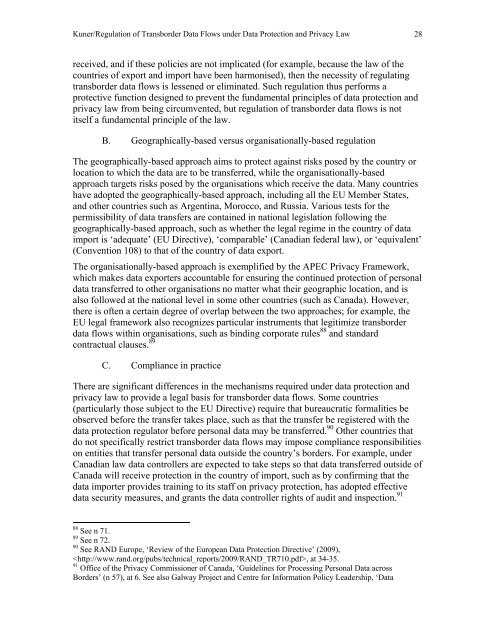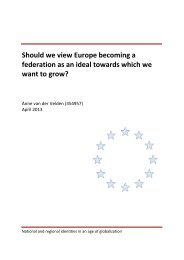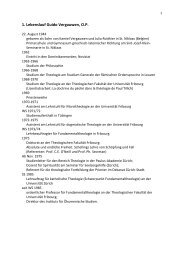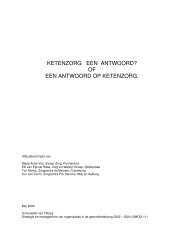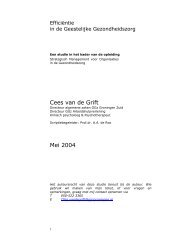Regulation of Transborder Data Flows under ... - Tilburg University
Regulation of Transborder Data Flows under ... - Tilburg University
Regulation of Transborder Data Flows under ... - Tilburg University
Create successful ePaper yourself
Turn your PDF publications into a flip-book with our unique Google optimized e-Paper software.
Kuner/<strong>Regulation</strong> <strong>of</strong> <strong>Transborder</strong> <strong>Data</strong> <strong>Flows</strong> <strong>under</strong> <strong>Data</strong> Protection and Privacy Law 28<br />
received, and if these policies are not implicated (for example, because the law <strong>of</strong> the<br />
countries <strong>of</strong> export and import have been harmonised), then the necessity <strong>of</strong> regulating<br />
transborder data flows is lessened or eliminated. Such regulation thus performs a<br />
protective function designed to prevent the fundamental principles <strong>of</strong> data protection and<br />
privacy law from being circumvented, but regulation <strong>of</strong> transborder data flows is not<br />
itself a fundamental principle <strong>of</strong> the law.<br />
B. Geographically-based versus organisationally-based regulation<br />
The geographically-based approach aims to protect against risks posed by the country or<br />
location to which the data are to be transferred, while the organisationally-based<br />
approach targets risks posed by the organisations which receive the data. Many countries<br />
have adopted the geographically-based approach, including all the EU Member States,<br />
and other countries such as Argentina, Morocco, and Russia. Various tests for the<br />
permissibility <strong>of</strong> data transfers are contained in national legislation following the<br />
geographically-based approach, such as whether the legal regime in the country <strong>of</strong> data<br />
import is ‘adequate’ (EU Directive), ‘comparable’ (Canadian federal law), or ‘equivalent’<br />
(Convention 108) to that <strong>of</strong> the country <strong>of</strong> data export.<br />
The organisationally-based approach is exemplified by the APEC Privacy Framework,<br />
which makes data exporters accountable for ensuring the continued protection <strong>of</strong> personal<br />
data transferred to other organisations no matter what their geographic location, and is<br />
also followed at the national level in some other countries (such as Canada). However,<br />
there is <strong>of</strong>ten a certain degree <strong>of</strong> overlap between the two approaches; for example, the<br />
EU legal framework also recognizes particular instruments that legitimize transborder<br />
data flows within organisations, such as binding corporate rules 88 and standard<br />
contractual clauses. 89<br />
C. Compliance in practice<br />
There are significant differences in the mechanisms required <strong>under</strong> data protection and<br />
privacy law to provide a legal basis for transborder data flows. Some countries<br />
(particularly those subject to the EU Directive) require that bureaucratic formalities be<br />
observed before the transfer takes place, such as that the transfer be registered with the<br />
data protection regulator before personal data may be transferred. 90 Other countries that<br />
do not specifically restrict transborder data flows may impose compliance responsibilities<br />
on entities that transfer personal data outside the country’s borders. For example, <strong>under</strong><br />
Canadian law data controllers are expected to take steps so that data transferred outside <strong>of</strong><br />
Canada will receive protection in the country <strong>of</strong> import, such as by confirming that the<br />
data importer provides training to its staff on privacy protection, has adopted effective<br />
data security measures, and grants the data controller rights <strong>of</strong> audit and inspection. 91<br />
88 See n 71.<br />
89 See n 72.<br />
90 See RAND Europe, ‘Review <strong>of</strong> the European <strong>Data</strong> Protection Directive’ (2009),<br />
, at 34-35.<br />
91 Office <strong>of</strong> the Privacy Commissioner <strong>of</strong> Canada, ‘Guidelines for Processing Personal <strong>Data</strong> across<br />
Borders’ (n 57), at 6. See also Galway Project and Centre for Information Policy Leadership, ‘<strong>Data</strong>


